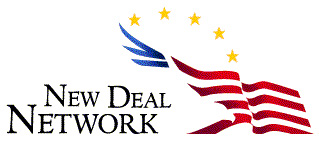talking history | syllabi | students | teachers | puzzle | about us
The New Deal Network
http://newdeal.feri.org/
Created by the Franklin and Eleanor Roosevelt Institute (FERI) and maintained by the Institute for Learning Technologies (ILT) at Columbia University. Thomas Thurston, project director and Web developer.
Reviewed May 20-Sept. 26, 2001.
When launched in 1996, The New Deal Network overnight became one of the first and largest historical archives to make use of the World Wide Web. Sponsored by the Franklin and Eleanor Roosevelt Institute and maintained by the Institute for Learning Technologies at Columbia University’s Teacher’s College, the site has been consistently one of the nation’s most popular historical sites both for its unparalleled archive of source materials devoted to the New Deal and for its pioneering efforts to use this new medium of the Internet to create a “network” of interested secondary and college teachers, the general public, and, to a somewhat lesser degree, scholars.

The archive currently contains twenty thousand items, of which seven hundred are documents; the rest are images. The editorial selection of documents has been self-consciously eclectic, guided by the particular interests of the editorial staff, serendipitous archival or publishing opportunities, or requests by the participants in the network for particular materials. Visitors seeking comprehensive or evenly balanced documentation of New Deal activities will inevitably be disappointed, but others will delight in the substantial clumps of sources around such appealing subjects as the letters of children to Eleanor Roosevelt, the Youth Conservation Corps, the Tennessee Valley Authority, WPA (Works Progress Administration) slave narratives, and New Deal murals. The editors have created seventeen special multimedia features, lesson plans, and presentations that provide a scholarly context for a large number of these sources.
Primary documents are rendered in what the editors call “anchored HTML” (hypertext markup language) files featuring numbered paragraphs (essentially the same as publishing a new edition of the document) instead of the somewhat more common (and recent) approaches using searchable facsimile images or more formal markup languages such as SGML (standard generalized markup language) and its subset XML (eXtensible markup language). The “anchored HTML” approach was originally designed to encourage direct linking to the archive’s digital manuscripts, but so far hyperlinked citations to potentially volatile HTML editions have proven in practice to be an inferior replacement for traditional citations to historical originals with page numbers or physical locations. A random comparison of the network’s HTML versions with the originals turned up a small number of typographical errors and misprints, but overall the quality of the sources was excellent if somewhat short of the fidelity required for advanced scholarly use. Images appear attractively as thumbnails next to individual catalog items and in an additional larger version suitable for classroom projection but not high-quality printing.
For access to this massive collection of primary images and documents, the New Deal Network relies chiefly on hyperlinked indexes to subjects, dates (years), authors, and publishers or collections from which you can view related items. While familiar and quite functional, these indexes would be easier to use if they allowed users more quickly to page through smaller groups of keywords, to see immediately how many items are associated with each keyword, and to move back and forth between the indexes and archive items without using the Web browser’s often unpredictable Back button. The search interface retrieved relevant records for both simple keywords and more advanced queries, although the underlying full-text search engine proved less useful than the more common archival search forms that facilitate searches for particular types of catalog information such as authors, subjects, or date ranges.
Overall, the New Deal Network's navigational structure was clear and effective but suffered at the lower levels from inconsistencies and frustrating dead ends due to phantom navigation bars left over from earlier stages of the site. Such minor glitches highlight the challenge of maintaining digital projects over the long term and the need for periodic digital renovations—much like their physical counterparts. Nonetheless, the network provides access to an unparalleled collection of materials about the New Deal and has proven consistently popular after many other digital projects have come and gone.
Charles Forcey
Columbia University
New York, New York
